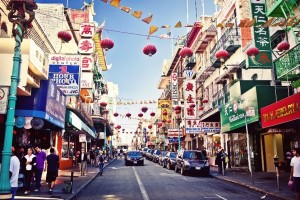 By Steve Blumenthal, CEO, CMG Capital Management Group
By Steve Blumenthal, CEO, CMG Capital Management Group
I walked through Chinatown in San Francisco last week. Block after block, store after store, all selling the same stuff (t-shirts, trinkets, etc.). Each looked exactly like the other. Susan and I were heading to rent bikes for a trip across the Golden Gate Bridge. That was wildly fun (and so was the wine and calamari in Sausalito). Susan asked, “How do they all survive?” The short answer is that not all will. I tried to explain it to her this way.
Some pay rent, others a mortgage and maybe one or two own their business properties outright. Of course, there’s a skill to running a business (purchasing, quality, selection, services, etc.) but not everyone has the gift. Throw debt into the mix whether it’s a mortgage or high rent and your challenges become greater.
Easy money has enabled a lot of people to go into business. In the Chinatown neighborhood, it was restaurants and novelty stores. Debt enables greater competition and greater competition puts pressure on prices and lower prices put pressure on margins. Those with high debt and rent bills will be the first to fail.
Suppose the store owner who pays high rent or has a large monthly mortgage payment drops prices by 30%. He is desperate to gain market share. Desperate to grow his way out of his financial stress.
Consumers flock to the best price. Sales spike at the expense of the other stores. Profit margins are less and his plan didn’t work for he or for the neighboring stores. Ultimately, those with high debts go bust first. Bankruptcies, bank losses, it trickles down. Others follow, the strong survive and with fewer stores in the game, pricing and profit margins improve. A new economic cycle follows.
Debt creates a level of complexity that when excessive slows growth and adds to the downside of an economic cycle. Whether it’s government debt, corporate debt, record high consumer credit card debt, record high global sovereign debt, record high emerging market debt or record high investor margin debt, what is clear, is that debt is excessive everywhere – thus the fragile state of the global economy.
I believe we need to recognize that we are dealing with a global debt deleveraging cycle that has happened many times in history, but it tends to occur maybe just once in an individual’s lifetime. To this end, I point you to a great research piece titled, “How The Economic Machine Works” by Ray Dalio and his team at Bridgewater Associates. Have your children and grandchildren read it. I think it can help us all be better investors.
Last week I wrote about the détente agreement made in mid-March at a meeting in Shanghai between the European Central Bank, the Japanese Central Bank, the Chinese Central Bank and the Fed. I tried to explain to Susan that the global situation is really like the store owners problems when the guy across the street cuts his prices by 30%.
In simplistic terms, one country can instantly cut its prices by manipulating its currency lower. The hope is that global consumers will buy from its country. The hope is that it can gain growth, at the expense of its neighbor, and grow its way out of debt and towards greater economic prosperity. The purpose of the meeting was to negotiate a truce.
The challenge is debt. We are all up to our eye balls in debt and smart guys pulling the monetary levers think they can fix the mess. So back to that complexity thing. A strong dollar slows U.S. growth and profits for our multi-national corporations. It drives capital into the U.S. and out of emerging markets. When the nearly $10 trillion in emerging market debt comes due, if the dollar is 30% higher (like it has grown over the last several years) the borrower must pay back to U.S. banks and lenders 30% more. Borrow $8 trillion, and pay back $10.4 trillion.
If China lowers versus the Yen and the Euro, what does that do to global capital flows, global sales and debt owed? What does it do to other Asian or Latin American borrowers who thought they were getting a deal expecting the dollar to move lower? At the time, it looked like the dollar was heading lower, not 30% higher.
The Fed agreed to backtrack on the rate hike thing with Janet Yellen sounding more dovish than she has since taking office. That is a major change from her comments in December and January.
So the big four store owners that account for roughly 70% of the global GDP got together and agreed “that monetary policies involving a currency devaluation by the Europeans and Japanese, or monetary policies involving currency appreciation by the US, would be counterproductive.”
Come on, folks. Add this to that they are making it up as they go, pause, test the waters, gauge the impact, pause, invent, gauge, move forward: what the Fed has seen each time they signaled a rate increase is another round of equity market turmoil. They saw what happened to the global markets (equity market turmoil) in August and again in January when China devalued its currency.
For the rest of the story see On My Radar: Stuck Between Three Rocks and a Hard Place.
The current opinions and forecasts expressed herein are solely those of Steve Blumenthal and are subject to change. They do not represent the opinions of CMG. CMGs trading strategies are quantitative and may hold a position that at any given time does not reflect Steve’s forecasts. Steve’s opinions and forecasts may not actually come to pass. Information on this site should not be used as a recommendation to buy or sell any investment product or strategy.
